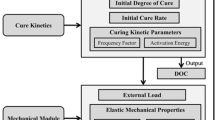Abstract
A modelling and simulation approach for plastic deformation effects in curing resins is presented. For this purpose known rheological models of viscoelasticity and viscoplasticity are combined and a thermochemical element is added to account for chemical shrinkage and thermal expansion. The degree of cure of the resin has a major influence on the behaviour of the curing material, and therefore, the material model is formulated depending on the degree of cure. It affects the viscoelastic behaviour as well as the chemical shrinkage and the yield function of the viscoplastic part of the model. For the yield function a von Mises approach with isotropic hardening is chosen, where the initial yield stress as well as the yield surface depends on the degree of cure and the temperature.
Similar content being viewed by others
References
Adolf D.B., Martin J.E.: Time-cure superposition during crosslinking. Macromolecules 23, 3700–3704 (1990)
Adolf D.B., Martin J.E.: Calculating of stresses in crosslinking polymers. J. Compos. Mater. 30(1), 13–34 (1996)
Adolf D.B., Chambers R.S.: A thermodynamically consistent, nonlinear viscoelastic approach for modelling thermosets during cure. J. Rheol. 51, 23–50 (2007)
Blumenstock, T.: Analyse der Eigenspannungen während der Aushärtung von Epoxidharzmassen. Dissertation, University of Stuttgart (2003)
Boey F.Y.C., Qiang B.: Experimental modeling of the cure kinetics of an epoxy-hexaanhydro-4-methylphtalicanhydride (MHHPA) system. Polymer 41, 2081–2094 (2000)
Ehlers W., Ellsiepen P.: PANDAS: Ein FE-System zur Simulation von Sonderproblemen der Bodenmechanik. In: Wriggers, P., Meißner, U., Stein, E., Wunderlich, W. (eds) Finite Elemente in der Baupraxis: Modellierung, pp. 391–400. Berechnung und Konstruktion, Ernst & Sohn (1998)
Ellsiepen P.: PANDAS user manual. Institut für Mechanik. Lehrstuhl II—Prof. Dr.-Ing. W. Ehlers . Universität Stuttgart, Stuttgart (2001)
Enns J.B., Gillham J.K.: Time-temperature-transformation cure diagram: modeling the cure behavior of thermosets. J. Appl. Polym. Sci. 28, 2567–2591 (1983)
Flügge W.: Viscoelasticity. Springer, Berlin (1975)
Fournier J., Williams G., Duch C., Aldridge G.A.: Changes in molecular dynamics during bulk polymerization of an epoxide-amine system as studied by dielectric relaxation spectroscopy. Macromolecules 29, 7097–7107 (1996)
Hahn, O., Jendrny, J., Figge, V.: Einfluss des Fertigungsprozesses auf die Verbindungseigenschaften geklebter Hybridstrukturen. Tagungsband des 1. Berichtskolloquiums der DFG-Forschergruppe “Hochleistungsfügetechnik für Hybridstrukturen”, Hannover, pp. 64–73
Halley P.J., Mackay E.: Chemorheology of thermosets—an overview. Polym. Eng. Sci. 36(5), 593–609 (1996)
Harsch, M.: Methoden und Ansätze zur spannungsarmen Vernetzung von Epoxidharzen. In: IVW-Schriftenreihe, vol. 76, pp. 150 (2008)
Haupt P.: Continuum Mechanics and Theory of Materials. Springer, Berlin (1999)
Hossain M., Possart G., Steinmann P.: A small-strain model to simulate the curing of thermosets. Comput. Mech. 43, 769–779 (2009)
Hossain M., Possart G., Steinmann P.: A finite strain framework for the simulation of polymer curing. Part I:. Elasticity. Comput. Mech. 44, 621–630 (2009)
Hossain M., Possart G., Steinmann P.: A finite strain framework for the simulation of polymer curing. Part II: Viscoelasticity and shrinkage. Comput. Mech. 46, 363–375 (2010)
Jendrny, J.: Entwicklung von Berechnungsmodellen zur Abschätzung der Verformung geklebter dünnwandiger Stahlbauteile in Leichtbaukonstruktionen während der Warmaushärtung. Schriftenreihe P513 der Forschungsvereinigung Stahlanwendung e.V., Düsseldorf (2004)
Kamal M.R.: Thermoset characterization for moldability analysis. Polym. Eng. Sci. 14, 231–239 (1974)
Kiasat, M.S.: Curing shrinkage and residual stress in viscoelastic thermosetting resins and composites. Dissertation, Delft University of Technology (2000)
Kolmeder S., Lion A.: On the thermomechanical-chemically coupled behavior of acrylic bone cements: Experimental characterization of material behavior and modeling approach. Tech. Mech. 30(1–3), 195–202 (2010)
Lion A., Höfer P.: On the phenomenological representation of curing phenomena in continuum mechanics. Arch. Mech. 59, 59–89 (2007)
Lührs, G.: Randwertaufgaben der Viskoplastizität—Modellierung, Simulation und Vergleich mit experimentellen Daten aus zyklischen Prozessen und Umformvorgängen. Dissertation, University of Kassel (1997)
Mahnken R., Schlimmer M.: Simulation of strength difference in elasto-plasticity for adhesive materials. Int. J. Numer. Methods Eng. 63, 1461–1477 (2005)
MatLab User Manual. Online documentation http://www.mathworks.com/help/ (2011)
Matzenmiller, A., Schlimmer, M., Mahnken, R., Hahn, O., Dilger, K., Gumbsch, P., Thoma, K., Hennemann, O.-D.: Methodenentwicklung zur Berechnung von höherfestigen Stahlklebverbindungen des Fahrzeugbaus unter Crashbelastung. Abschlussbericht zum AiF/FOSTA ZUTECH-Forschungsprojekt P676, Forschungsvereinigung Stahlanwendung e.V., Düsseldorf (2008)
Retka, J., Höfer, P.: Numerische Simulation aushärtender Klebstoffe. Tech. Rep., Universität der Bundeswehr München (2007)
Schlimmer, M., Hahn, O., Hennemann, O.-D.: Methodenentwicklung zur Berechnung und Auslegung geklebter Stahlbauteile für den Fahrzeugbau. Abschlussbericht zum AiF/FOSTA ZUTECH-Forschungsprojekt 76 ZN, Forschungsvereinigung Stahlanwendung e.V., Düsseldorf (2004)
Schwarzl F.R.: Polymermechanik—Struktur und mechanisches Verhalten von Polymeren. Springer, Berlin (1990)
Sourour S., Kamal M.R.: Differential scanning calorimetry of epoxy cure: isothermal cure kinetics. Thermochim. Acta 14, 41–59 (1976)
Tobolsky A.: Mechanische Eigenschaften und Struktur von Polymeren. Berliner Union, Stuttgart (1967)
White S.R., Hahn H.T.: Process modelling of composite materials: residual stress development during cure. J. Compos. Mater. 26, 2402–2453 (1992)
Yagimli B., Lion A.: Modelling and simulation of curing processes of epoxy resin. PAMM 9, 325–326 (2010)
Yagimli B., Lion A.: Experimental investigations and material modelling of curing processes under small deformations. ZAMM 91, 342–359 (2011)
Author information
Authors and Affiliations
Corresponding author
Rights and permissions
About this article
Cite this article
Liebl, C., Johlitz, M., Yagimli, B. et al. Simulation of curing-induced viscoplastic deformation: a new approach considering chemo-thermomechanical coupling. Arch Appl Mech 82, 1133–1144 (2012). https://doi.org/10.1007/s00419-012-0639-z
Received:
Accepted:
Published:
Issue Date:
DOI: https://doi.org/10.1007/s00419-012-0639-z




